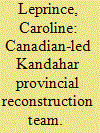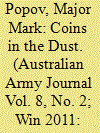| Srl | Item |
| 1 |
ID:
124418


|
|
|
|
|
| Publication |
2013.
|
| Summary/Abstract |
The record of the Canadian-led Provincial Reconstruction Team (PRT) in Kandahar province, Afghanistan, provides a unique opportunity to evaluate the efficiency of Canada's recently adopted whole-of-government approach to conflict situations. This study maps the evolution of the interagency dynamics of Canadian departments and agencies during their six-year involvement with the PRT, and reveals that the Canadian-led PRT had to undergo significant changes before real interdepartmental collaboration actually could take place. While the first two years of the implementation of the whole-of-government approach have been described as a failure, this article argues that the publication of the Independent Panel on Canada's Future Role in Afghanistan was the turning point that significantly improved interagency collaboration in the PRT.
|
|
|
|
|
|
|
|
|
|
|
|
|
|
|
|
| 2 |
ID:
106176


|
|
|
| 3 |
ID:
121896


|
|
|
|
|
| Publication |
2013.
|
| Summary/Abstract |
Canada's counterinsurgency in Kandahar province, Afghanistan, involved two distinct operational strategies: an initial enemy-centric strategy and, after 2009, a population-centric strategy. Using insurgent-initiated attacks against civilians as a measure for the level of control and security provided by the counterinsurgency, this article tests the effectiveness of these two strategies using a quasi-experimental research design. This article finds that a population-centric counterinsurgency strategy that aimed to provide security to the population rather than destroy the insurgency resulted in the most controlled and secure environment for the civilian population. To the extent that a secure civilian population is important for successful counterinsurgency, the post-2009 population-centric operational strategy of the Canadian Forces, International Security Assistance Force (ISAF), and the United States increased the chances of a successful counterinsurgency in Afghanistan.
|
|
|
|
|
|
|
|
|
|
|
|
|
|
|
|